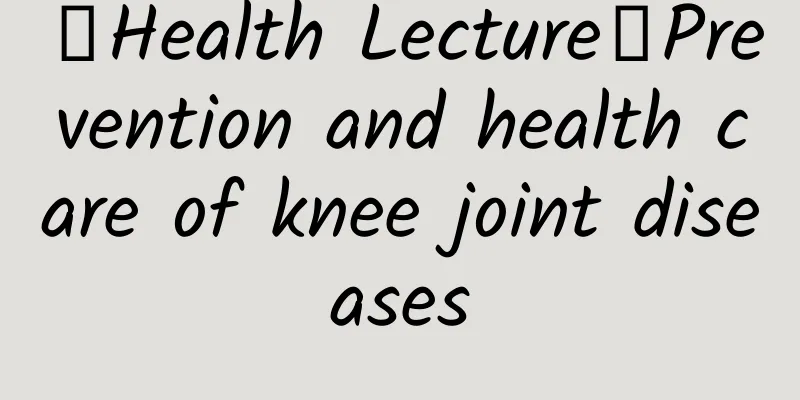【Health Lecture】Prevention and health care of knee joint diseases

|
As the saying goes, people age first with their legs, and the knee joint is the largest and most complex joint in the human body. It not only bears the pressure of the body's weight, but also mobilizes various structures of the body to participate in movement, which makes it easy to get injured. Daily walking, running, and jumping will consume energy, and the knee joint is under pressure all the time. The load on the knee joint is different in different states: when lying down, the load on the knee joint is almost 0; when standing and walking, the load on the knee joint is 1 to 2 times the body weight; when going up and down stairs, it is 3 to 4 times the body weight; when running, it is 4 times the body weight; when squatting and kneeling, it is 8 times the body weight. Bad habits can damage the knee joints, such as crossing your legs, kneeling, squatting, and sitting for long periods of time, which can reduce the transfer of nutrients to the joint bursa. The loss of knee cartilage is silent and hard to detect. At first, it may just be an occasional popping sound when squatting, which gradually evolves into long-term discomfort in the knee joint after running, and finally into joint stiffness and even the need for surgery. These knees really need to be used sparingly. Speaking of knee popping, some elderly friends may ask: When the knee joint moves, there is a popping sound, is this arthritis? Let's first talk about why the knee joint makes noises. This kind of clicking may be caused by the vibration of the gas in the joint cavity. The gap in the joint cavity is filled with liquid, which allows the joint to work smoothly and lubricatedly. When the joint moves, an obvious cavity appears in the middle of the joint cavity. The surrounding gas will diffuse into the cavity and, together with the liquid, make a crisp sound. If after a doctor's examination, it can be determined that there is no joint disease, then it is simply a clicking knee. The impact on the human body is not significant, so there is no need to worry. However, if you feel obvious pain in the knee joint when doing movements such as squatting, it may be pathological clicking. Pathological clicking is generally caused by small joint dislocation, local ligament calcification, articular cartilage damage, uneven patellar ligament muscle tension, etc. This is what we usually call osteoarthritis. When the knee joint is injured, its distress signal is just one word - pain Our most intuitive feeling is that after standing or walking for a long time, or just running a few steps, the knee joints will feel sore or even painful. Does this mean that there is something wrong with the knee joints? Different pain methods represent different problems. Pain after weight-bearing exercise is a signal of ligament edema. If there is obvious tenderness below the front of the knee joint, and swelling can be felt when touching it, this situation indicates that there may be ligament edema. Applying ice to the knee joint immediately can quickly reduce the ligament edema. Pain only in the early morning is a sign of degenerative knee disease. If you just wake up in the morning, you will feel pain when you bend your knee joint, but the pain will gradually disappear as the amount of activity increases. This type of pain often occurs in the early stages of degenerative knee disease. Pain when you bend it slightly is a sign of damage to the patella or articular cartilage. When going up and down stairs, climbing a mountain, or squatting, if there is tingling, soreness, or weakness in a fixed position of the knee joint, this means that you may have damage to the patella or articular cartilage. In particular, the pain will be more severe when going down stairs than when going up stairs. In this case, the patella is more likely to be damaged. If there is pain in a fixed position on the inside or outside of the knee joint, and the pain is more obvious when pressing, this indicates that there may be meniscus damage. Inability to bend is a sign of damage to multiple structures. No matter what the circumstances, the knee joint suddenly develops a noose symptom - that is, during activities such as walking and squatting, the knee joint suddenly becomes stuck and cannot move, accompanied by obvious pain. This indicates that there may be loose bodies or meniscus damage after cartilage damage. How to protect the joints? What should we do if there are problems with the joints? ※ The first is "use sparingly", that is, "appropriate and moderate exercise". Exercise is good for the elderly to enhance heart and lung function and reduce blood sugar and blood lipids, but it hurts the joints. Appropriate activities include static squats, aerobics, jogging, low-intensity swimming and "square dancing"; climbing mountains and stairs is strictly prohibited. Moderate exercise means you can stop when you sweat a little, and half an hour is enough. This can not only bring out the benefits of exercise, but also avoid damaging the joints. ※ Lose weight - Losing weight can reduce stress and wear on joints. ※ Vitamin D-calcium compound preparations, etc., to strengthen subchondral bone and protect joint surfaces. ※ Take glucosamine or inject sodium hyaluronate into the joint to increase the nutritional source for articular cartilage repair. ※ Acupuncture, physical therapy, hot compress and massage can all promote local blood circulation, promote joint repair and alleviate symptoms. ※ When you feel pain, you can apply plasters externally, take non-steroidal anti-inflammatory drugs orally, and Chinese patent medicines that have the effect of promoting blood circulation and removing blood stasis to relieve symptoms. ※ Surgery can be considered for patients with loose bodies formed by cartilage exfoliation in the joint, and patients with meniscus tears that cause compression and locking symptoms. Traditional Chinese Medicine Treatment: Traditional medicine believes that a person is an organic whole. The various symptoms of knee pain are manifestations of abnormal qi and blood in the whole body, so while treating knee joint diseases, it is also necessary to take Chinese medicine that nourishes the liver and kidneys, strengthens the muscles and bones, and promotes blood circulation and removes blood stasis. This can fundamentally improve the patient's knee joint clinical symptoms and adjust the normal operation of the body's qi and blood. The combination of treatments including acupuncture, moxibustion, massage, cupping, Chinese medicine soaking, Chinese medicine fumigation and washing can quickly reduce joint swelling and pain, improve fibrosis caused by excessive load on the tissues around the joints, and improve the flexibility of the joint capsule and ligament tissues around the knee joint, thereby improving the range of motion of the knee joint and reducing the pain of the knee joint. For patients with stubborn pain and clear pain points, appropriate needle knife release can speed up symptom relief and increase the patient's confidence in treatment. If you often have knee pain and do not pay attention to it, it will lead to more serious joint damage or even osteoarthritis. In short, we must pay enough attention to knee problems, take precautions before they happen, and protect our joints. About the Author: Sun Dianjia, attending physician of the Department of Traditional Chinese Medicine of Heilongjiang Provincial Geriatric Hospital (Heilongjiang Provincial Fifth Hospital), has been engaged in clinical work of Traditional Chinese Medicine for more than 10 years and has rich clinical experience. He is good at using acupuncture, floating needle, needle knife, tendon needle, massage and other techniques to treat common and frequently occurring orthopedic diseases. |
<<: "Praising" is good for your health, so you must do it more often!
>>: CNBC: Survey shows the most popular companies: Twitter and Facebook are at the bottom
Recommend
Caesarean section, 20 days after sex, she died
It is very bad for women to resume sexual life to...
How important is the liver to us? Let's take a look at the fate of a liver
Author: Sun Yuhang and Zhou Yixi Medical College ...
What kind of underwear should girls wear?
Many people say that it is good for the physical ...
What to do if there is too much vaginal discharge during pregnancy
Leucorrhea is originally a liquid secreted from t...
I have an incompetent cervix. How can I keep my baby?
Author: Zou Liying, Chief Physician, Beijing Obst...
Dull pain above left breast
When a woman feels a dull pain above the left bre...
Is it normal to have back pain after an abortion?
Abortion has a great impact on women's health...
After the Waking of Insects, eating spring bamboo shoots is a big deal! They are so fresh and tender!
The third solar term of spring, Jingzhe, is comin...
What should I do if a girl has a mustache on her mouth?
I believe everyone is familiar with the symptom o...
There is white discharge in the female urethra
Generally, women need to learn to protect every f...
What to do if a woman smells down there
Foul odor is generally the main symptom of vagini...
What are the reactions to insufficient amniotic fluid?
If there is insufficient amniotic fluid, pregnant...
Is it good for pregnant women to drink yogurt every day?
Every girl likes to drink yogurt. Some female fri...
Tips for dealing with breathing difficulties in late pregnancy
During pregnancy, pregnant women are prone to var...
What to do if you are allergic to caesarean section tape
Many people are allergic, but basically everyone&...









